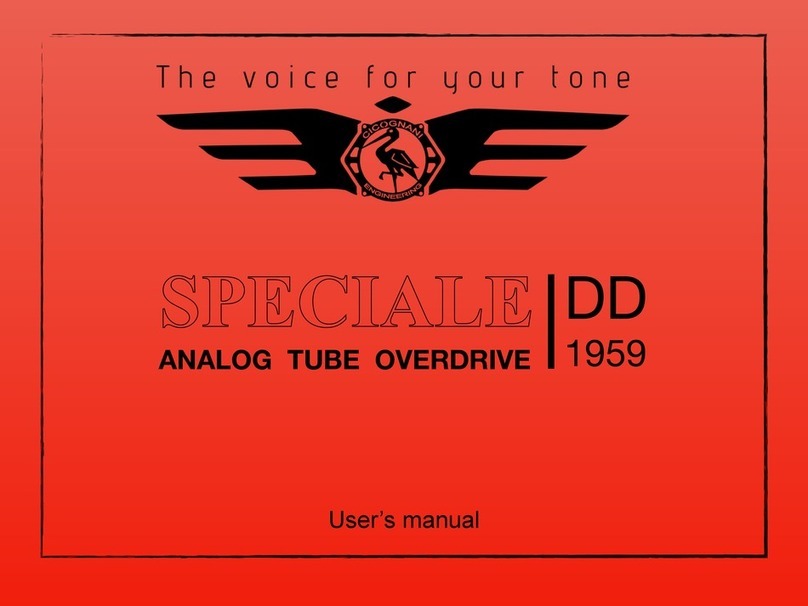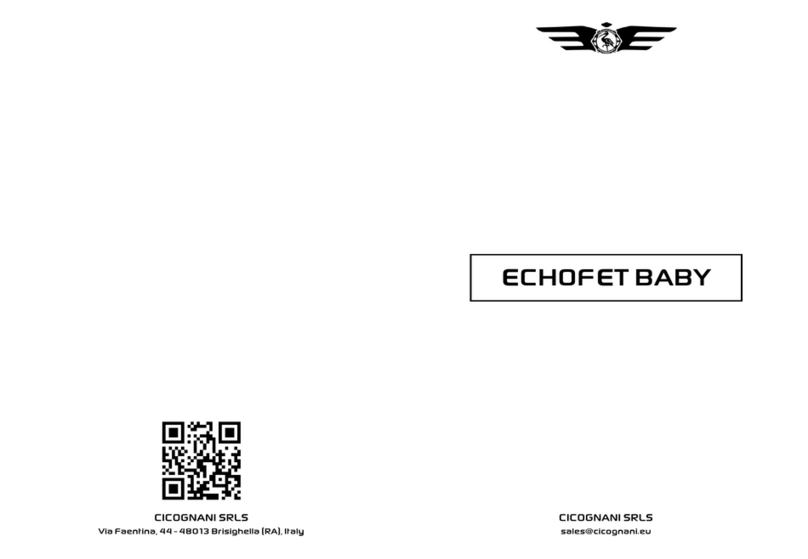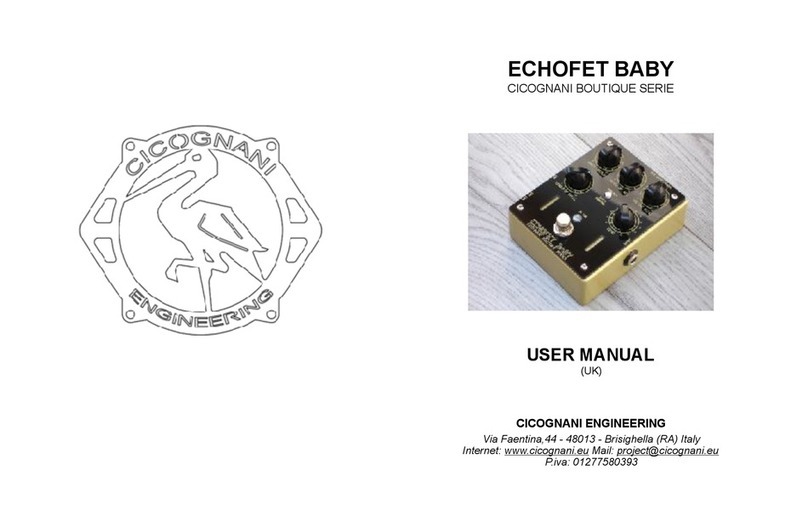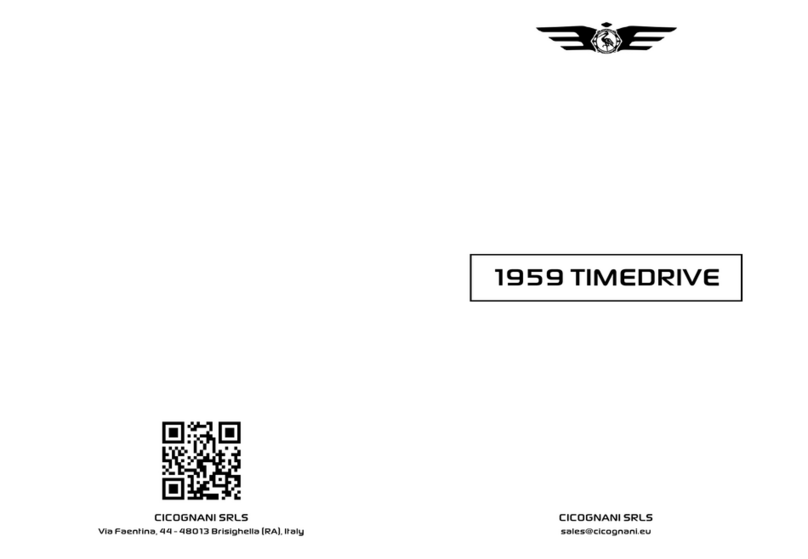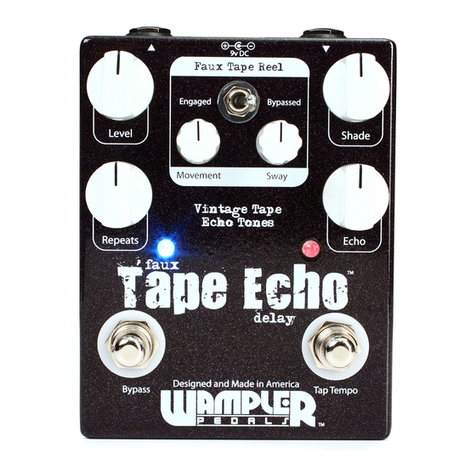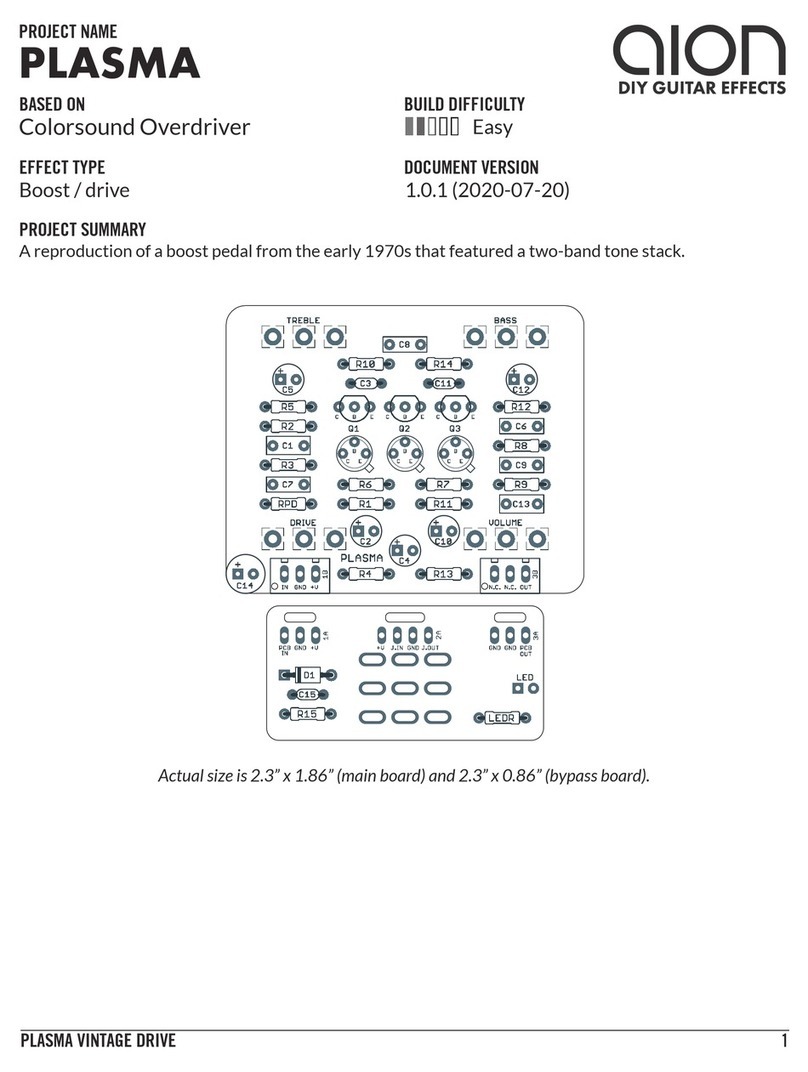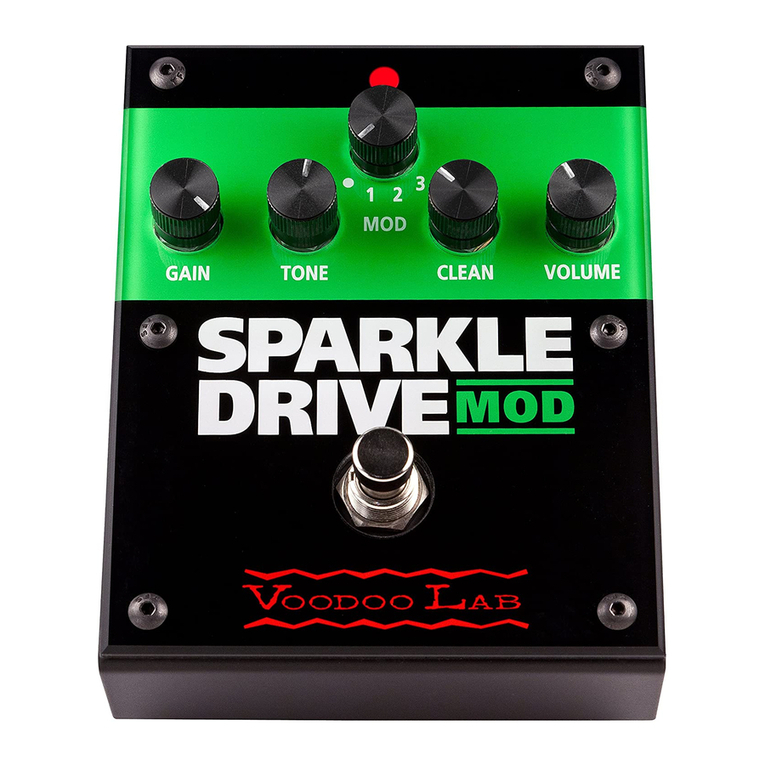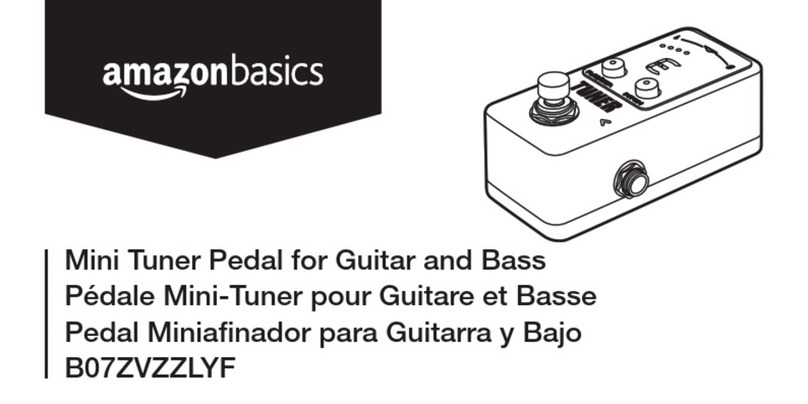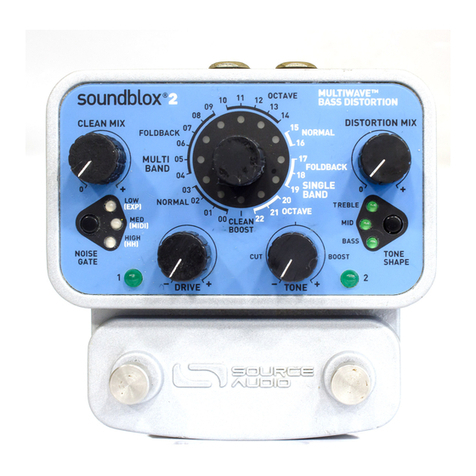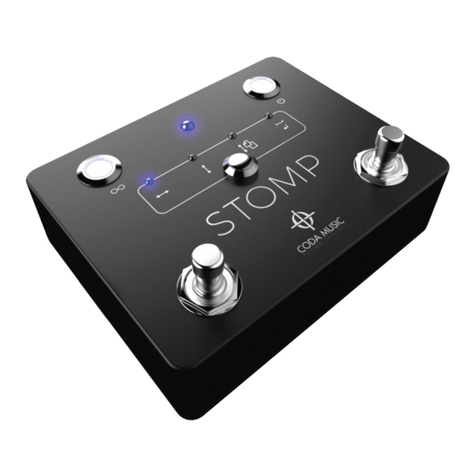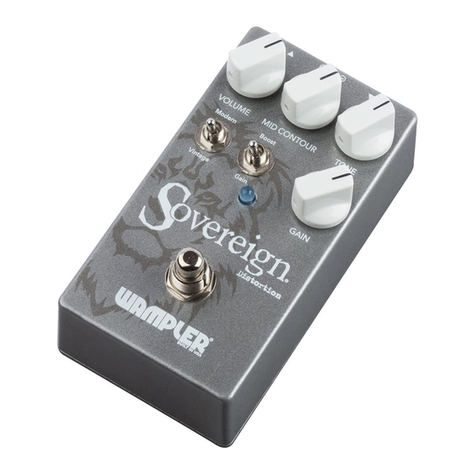CICOGNANI ENGINEERING Pompeii PE603 User manual

POMPEII
FOUR HEAD SONIC ECHO
PE
603
|
User’s manual

POMPEII PE603 Model
Cicognani engineering like to congratulate you on your purchase of your new Pompeii PE603. It is one of most
advanced Echo unit ever created. We hope this would help your creativity and better your sound. The Glorious Old
Italian Echo at the today time. !
The great experience and knowledge of Guglielmo (The Guru) has been made available to create not a simple "relic"
of that fantastic PE603 echo but a modern vision of the most beautiful sounds of past.
Some guidelines to design this unit:"
* No mechanical part in movement; no maintenance needed; robust metal case in pedal size."
* Extreme Audio Quality: Great linearity of the signal designed with a new valve preamplifier combined with a cascode
Jfets. The sound has excellent benefits."
* The VARISPEED, born in the past as a modification to reduce the speed of motor; has been redesigned keeping
unchanged the concept of lengthening the time keeping the heads synchronized. With good quality we managed to
reach 660mS in combination with the head 4.
!
Vintage model of PE603 echo, has been used by many bands as an effect on vocals, instruments, PA. Needless to
say, many musicians have used it in different styles. It is a "creative machine" that enriches the sound thanks to its
unmistakable "feedback halos”. Many different effects can be had by selecting combinations of the 4 replay heads via
the "switch" control. "
The Echo/Repeat function, switch between a single or multiple repeats. With the Length Of Swell pot. controlling the
amount of feedback; from minimal subtlety to frenzied cosmic mayhem....and this makes it truly unique and creative.

A Bit of Echo History
The Italian Echo Units were produced by the famous Italian company in Milan since the 60s. They were soon
appreciated all over the world and used by many artists including: Pink Floyd, Led Zeppelin, The Shadows, etc. Even
today it is much appreciated. In several years of my career, I have had the opportunity and the pleasure of repairing,
and restoring many, so that I can understand the product well. The operating principle is based on the "filophone"
magnetic wire recorder. This aluminum drum with some coils of magnetic wire wound around it and are positioned
around it: demagnetizer, recording head, play heads. The historic echo models of the famous Italian company worked
with 4 play heads; some models from the 70s were then expanded and equipped up to 6.This process required
constant maintenance of cleaning and lubrication of the touch parts. A technical feature that saw assigning the longest
time was the maximum space between the recording head and the most distant play in about 300ms. !
"
!
Measured many units and the average of them offered these delay times:
First Tap = 74mS"
Second tap = 148mS"
Third tap = 222 mS "
Fourth tap = 296mS
It should also be kept in mind that the motor speed in a European main"
power will be about 20% compared to that America.

Introduction:
The Echosex 2°, Echosex 2°LTD, Echosex T7E and Echofet Baby projects, conceived by Guglielmo of Cicognani
engineering factory, have been appreciated worldwide receiving many awards. "
With POMPEII PE603, we have recreated the sonic details of the old historic Italian echo while preserving the most
important principles. "
"
Thanks to today's techniques and maintaining the vast majority of the analog circuit, Pompeii offers:"
1) Better and more defined sounds"
2) No maintenance required"
3) Robust metal case in pedal size
This was caused by: !
New tube / jfet cascode preamplifier that in addition to great linearity improves the headroom compared to the
designs of my previous models.
Best audio components; extreme evolution of the circuit.
No moving parts, no rubber parts that can wear out.
The chassis has been completely redesigned in order to be more beautiful, robust and easy to assemble and
disassemble. This allows the valve to be replaced with greater comfort."
"
Creating "Pompeii" was very demanding. I performed many test analyzed the direct and recording signals. We have
checked and rechecked the average delay time and synchronized on the subject of a real evolution of the product.!

Design:
"
Andrea Cicognani Head of Design!
Pompeii PE603 was born to celebrate the 25th Anniversary of Cicognani engineering. Unlike the LTD of the 20th Anniversary it will not
be built in a limited edition but guaranteed the production in Italy.
The front panel is made of PMMA and personally designed by
me. Cutting and writing is done using our CNC laser. All the
commands are there; all at your fingertips. The texts recall the
original ones of the time with added VARISPEED (born to vary the
motor speed in order to lengthen the echo delay in a
synchronized way on the heads) and MAGIC OF AGE (a particular
modulation once due to the wear of the mechanics that moved
the “drum”).The head matching tables are specially placed near
the source that illuminates the panel green so as to be more
visible.
The metal chassis is completely new and made in just two pieces. This time the well-known engineer and dear
friend Marcello Zama has really surpassed himself. Its principles are compact, durable and easy to assemble.The
parts bent to the foot switch side, have been specially created with two features: the first panel protection and the
second to better diffuse the back lighting of the panel.

The hammered silver paint is made by artisans as it used to be. These
paints in the past were used in Italy on industrial machines because more
resistant than the standard ones.!
This means that each product, while maintaining a similar appearance,
cannot be the same as the other, since the particular "hammered" effect
occurs in a different way in drying.!
My PCB désign:!
I was born a few years ago and worked in my first career in "point to point" built electronics now known as "hand
wired". I have drawn by hand a number of circuits that I don't even remember anymore! Then comes the computer
with ever better technologies and software able to do so many beautiful things automatically. One of my secrets is that
I continue to draw the circuits by hand because I have a better view of the passage of audio signals. This allows me to
pay more attention to the quality of the sound, and to the aspect of the positioning of the components which
facilitates repair. Usually I have in mind the functions it has to perform and how once mounted it will have to play. I
believe that this type of production must be done in Italy because it follows a typical culture that can hardly be
delegated to other countries mainly due to a meticulous assembly.
Of course, it is thought to be a “Boutique”, no compromises product and I
know that everything will not be built in many thousands of pieces."
The components are of the highest quality and chosen to last over time. !
The circuits are tested after assembly and then undergo the final PDC "
(pre delivery check). The tests we perform are not just about functionality but
include a complete view: Functionality, check on the valve triode balanced
and microphonicity, tolerance of digit-head delay times and sound. Only in
this way Pompeii can enter to the sale. "
The Guru!

The Guru’s Advice
1) Connect the main power to 12Vdc (min 500mA). Make sure the power supply is negative tip.!
2) Connect the “Output” to the amplifier “Input”.!
3) Connect the “Input” to the instrument.!
4) Set the “Input Volume”. The input volume is displayed by "Input Level" and can be adjusted from super clean to
overdrive. (this function is assigned only to repetitions)!
5) The bypass foot switch is factory set ON / OFF. It is however possible to set the “fade-out” mode by removing the
jumper located on the opposite side to the front panel.!
6) Choose the Echo mode by the 3 position mode “Selector”."
* Echo: Classic 60’s “slapback echo”. One single repeat from the selected head (no feedback available)"
* Rep.: Normal echo mode with selectable heads in feedback combinations."
* Swell: The typical Old Italian reverb effect made with the use of all the heads simultaneously.!
7) “Switch", the selector has the task of choosing the heads and their combinations. The combinations are exactly
the first 12 positions of the vintage PE603.!
—— PLAYBACK HEADS ——

One example in Rep. mode: If you select the “5 position” switch, call together the fourth and third heads, it will mean
the 4th Head considered as an 8th note, and 3rd head is equal to a dotted 8th. If you use the “varispeed” you can
keep the synchronism by increasing the delay time over 100%.!
The Length of swell (feedback) and Tone:"
Use the feedback control to create the tridimensional carpet of sound. The “tone” control is strictly connected to the
feedback and its task is to change the tonality of the oscillations. With this command you can repeat the most brilliant
or darkest notes to infinity. The Tone control is then assigned only to repetitions.!
The Magic of Age:"
This simulates the mechanical aging of the glorious Old Italian Echo. Is a particular modulation that acts on the echo
delay. Actually it happens in the same way as an old worn out mechanic. The "Magic of Age" control creates a unique
and sexy effect that can be adjusted to your personal taste.!
The Volume Echo:"
Is the parallel mix of the effect. It can be adjusted from 0% to 50% of the 50% dry signal. This analog mixer has been
completely redesigned to keep pure performance in all conditions of use. (The Volume Echo does not work in the
“wet-out” socket.!
"
"
Again, thank you for purchasing and welcome to “The Best Voice for Your Tone”.

Controls:

1) Main Power: DC plug 5,5 x 2,1mm. 12Vdc min. 350mA (0,35A) - suggested 12Vdc 500mA.!
2) Instrument Input: Standard 1/4” (6,3mm.) mono jack.!
3) Out: Standard 1/4” (6,3mm.) mono jack.!
4) Wet-Out: Unbalanced Lo Z 100% effect out. Standard 1/4” (6,3mm.) mono jack able to connect to mixing
consoles.!
5) Volume Echo: Set the mix of Volume Echo.!
6) Switch: Heads selector; 12 position switch to select the head combinations. "
(as playback heads shown in the map)!
7) Selector: Three mode selector; Echo (single rep. without feedback; Rep. (Classic Echo with feedback); Swell
(Reverberation created by all the heads simultaneously)!
8) Length of swell: More known as feedback. From one to infinite repetitions.!
9) Input Control: Setting the input volume that you can checking to the “Input Level” (The magic eyes).!
10) Varispeed: Change the base delay time - from 300mS of Classic Old Italian Echo to max 800mS.!
11) Magic of Age: Modulation that simulates the status of mechanical degradation.!
12) Bass/Treble: Is the tone of repeats.!
13) Bypass: Effect ON/OFF!
14) 12AU7B/ECC82 Tube: The dual triode tube preamp. !
15) Input level: The solid state “Magic eyes”

Combinations Playback Heads:
74 > 148mS
148 > 296mS
222 > 444mS
296 > 592mS
HEAD 1
HEAD 2
HEAD 3
HEAD 4
1
2
3
4
5
6
7
8
9
10
11
12

The minimum values shown in the table are with "varispeed" rotated in the 0% position, while the maximum
values are 100%. The minimum values are with a 1% THD tolerance, while the maximum ones are 5%. However
the synchronism of the heads remains very precise. The harmonic distortion ranges from 1% on the delay time
348mS to 5% in the maximum condition of 592mS.!
The heads are made with 4x PT2399. These well-used components offer great performance and above all can
be found anywhere in the world. The different filters of each head are calibrated to recreate the same sound
conditions as the old Italian echo.!
The feedback generated by Pompeii PE603 returns in the style of the award-winning LTD model in order to favor
those beautiful sound carpets often used in the past to compose the most beautiful arpeggios and psychedelic
sounds.
POWER IN
9 to 12VDC (NEGATIVE TIP)
CONSUMPTION
FROM 350 TO MAX 500mA
INPUT IMPEDANCE
< 1M OHM
INPUT SENSIVITY
1 Vpp MAX
OUTPUT IMPEDANCE
< 47K OHM
WET OUT IMPEDANCE
< 47K OHM
LINEARITY RESPONSE
7Hz TO 200Khz @ 1db
S/N RATIO PREAMP
< 91db
S/N RATIO HEADS
- 90dbV
EFFECT MIX LEVEL
MAX 50%
WET OUT MIX LEVEL
100% WET
HEADS TIMES
874 - 148 - 222 - 296mS
VARISPEED MAX TIME
+ 100% MAX (592mS)
HEADS DISTORTION
MAX 5% THD
TONE FREQUENCY
ROLL OFF 1Khz @ 6db/oct
SWITCHING MODE
REED RELAYS
INPUT BUFFER
1/2 12AU7B
OUTPUT BUFFER
1/2 12AU7B
INT. WORKING VOLTAGE
MAX 24VDC
ESTIMATED TUBE LIFE
UP TO 3000 HOURS
WIDTH
MAX 220mm. (8,6”)
LENGTH
MAX 130mm. (5,1”)
HEIGHT
MAX 50MM. (1,96”)
WEIGHT
0,7Kg. (1,5 lbs)
Technical Details:

Block Diagram:
The diagram 1 represents the principle mode of the function selector (Echo- Rep. - Swell) and the head selector.
It must be considered that the latter works in relays interfacing to provide a quieter commutation.
Block diagram 1

The diagram 2 is the complete operating system. As you can see the valve returns to be used both on the input
and output stage, with great benefits on the sound. The dynamics of the signal was more high, thanks to the
voltage doubler, which in this way allows not to saturate the input in combination with a big signals.!
The block diagram is an evolution of the T7E project where many changes take place: The switching system, the
signal path, the adjustment of the head map to the PE603 model, the feedback mix system, the bypass where
the mute relay is been deleted.
Block diagram 2

Input Instruments Connection:
"
To the Input you can use many different instrument lo and hi impedance as: Guitar, bass, mic preamplifier, keyboards,
etc. The input control must be adjusted so that you can use the right amount of signal. The input level (magic eye)
will help you understand how to adjust the levels.!
Attention!! The input level adjustment is very important as it affects the behavior of the echo sound. With low input
levels the mix may not reach a good presence while high levels may introduce harmonic distortion on repetitions.
I do not recommend the use of echo in distortion due to high input levels as it is "not very musical". I think it is
better to use an overdrive or fuzz between the instrument and the echo. The repetitions in this way are more
precise and defined. It is only a personal opinion !!!!

The Pompeii PE603 can be used with different types of instruments with output signals max 1Vpp and high or low
impedances.The Old Italian echo was used as the main PA effect and shortly thereafter along with many
instruments of the band. Today Pompeii wants to retrace those steps by offering wider compatibility even with the
most modern instruments.!
The new Pompeii PE603 offers unlimited possibility that you can needs both in live or in recording applications

The Echo in Front the Amp:
The use of the echo in front of the amplifier is one of the most classic configurations. Thanks to a powerful input and
output buffer we can send a good and clean signal to the amplifier. The use of good quality cables is always
recommended.If you use Fuzz, Od. or Dist. pedals move the echo to the end of the chain to obtain the best
performance

The Echo in Loop Effects:

The Echo in a Mixing Console

Special feature and function:
"
The “Pompeii tube” is a 12AU7/ECC82 it guarantees a good duration and linearity. However, it can also be
replaced with 12AX7/ECC83"
On the underside of the pedal it is easy to see a small window where a jumper is housed. Removing this switch
activates the "tail fx" function. A careful adjustment of the "length of swell" will be necessary to ensure that in the
moment of bypass the "tail" is not excessive.!
The working current of the marked pedal is 12VDC / 500mA as it is the best option for the best performance. It is also
possible to use 9VDC / 500mA, taking into consideration that the performance will suffer a very slight degradation. "
Be very careful that the main power supply is correct. If Pompeii is under-powered it is possible to notice
malfunctions on the selection of the heads and an increase in the background noise.!
The "Wet / Out" is a buffer-equipped output that provides a low impedance signal (line output). The connection is via
6.3mm mono jack.!
The calibration of the feedback for each single head is fixed and made at the factory. Inside Pompeii the only possible
settings are those of bias and vu. Adjustment by unqualified personnel is not recommended.
Table of contents
Other CICOGNANI ENGINEERING Music Pedal manuals
Popular Music Pedal manuals by other brands

Providence
Providence ANADIME CHORUS ADC-4 owner's manual
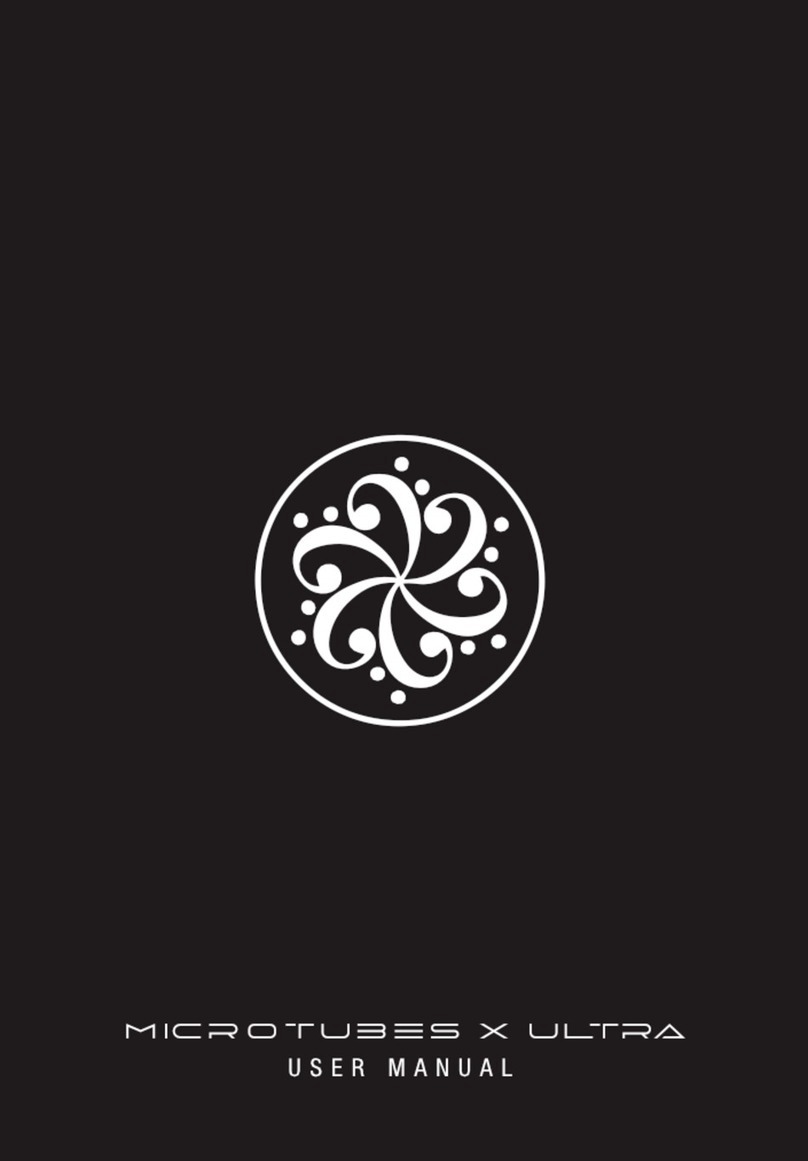
Darkglass Electronics
Darkglass Electronics Microtubes X Ultra user manual
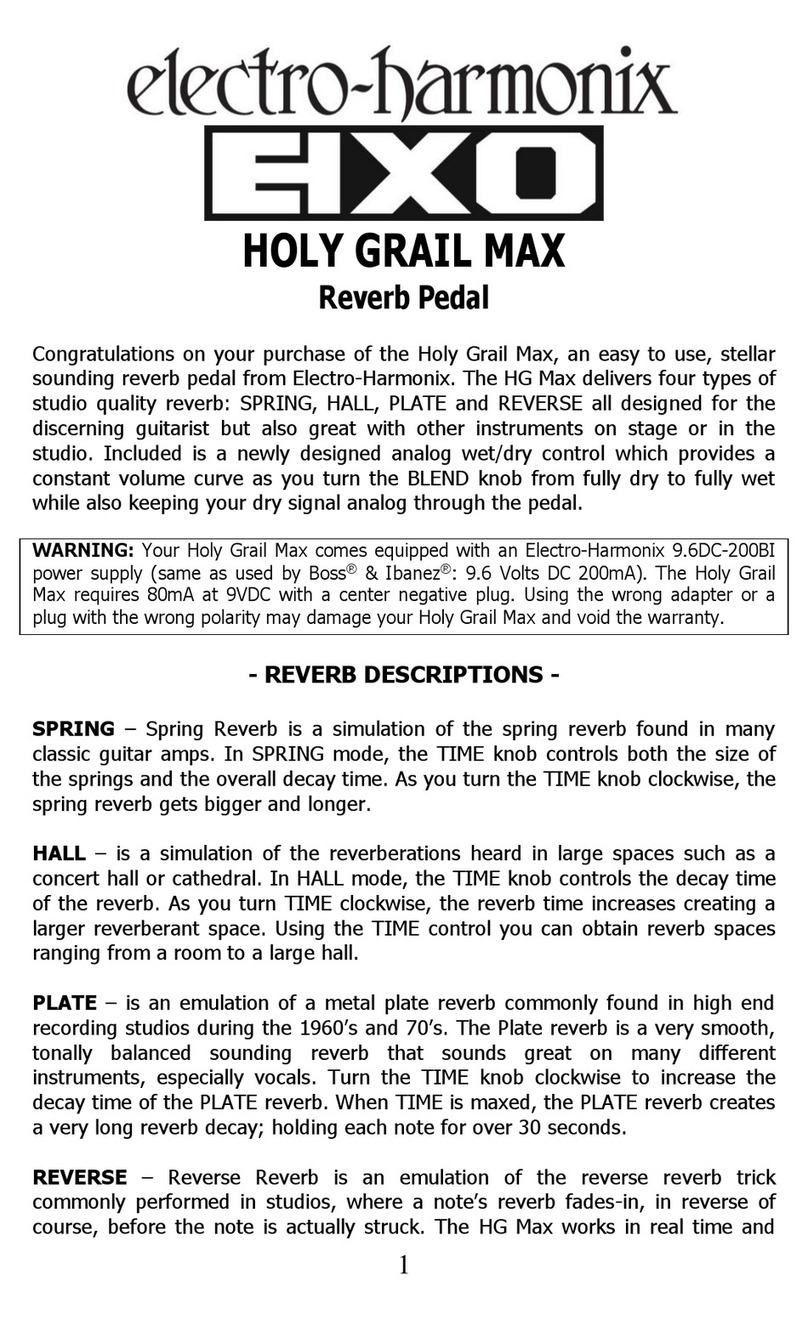
Electro-Harmonix
Electro-Harmonix HOLY GRAIL MAX quick start guide

Harley Benton
Harley Benton British TrueTone user manual

Catalinbread
Catalinbread Galileo Operation manual

Malekko
Malekko SNEAK ATTACK user manual
